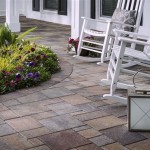How to Effectively Fix Slippery Concrete Patio
Concrete patios are an excellent addition to any home, providing a durable and versatile outdoor space. However, over time, exposure to the elements and foot traffic can make concrete patios slippery and dangerous. If you find yourself with a slippery concrete patio, don't despair; there are several effective ways to restore its grip and prevent accidents.
Identifying the Cause of the Slippery Surface
Before attempting to fix the slippery surface, it's essential to identify the underlying cause. Common culprits include:
- Sealing Issues: Improper sealing or worn-out sealant can allow moisture to penetrate the concrete, creating a slippery surface.
- Efflorescence: This white, powdery substance forms on concrete surfaces when water evaporates, leaving behind mineral salts that can create a slippery layer.
- Smooth Finish: Smooth-finished concrete lacks the texture necessary for good traction.
Methods to Fix Slippery Concrete Patio
Once you've determined the cause of the slippery surface, you can apply the appropriate solution:
1. Re-Sealing
If the slippery surface is due to sealing issues, re-sealing the patio is essential. Use a high-quality sealer specifically designed for concrete patios. Follow the manufacturer's instructions carefully to ensure proper application.
2. Removing Efflorescence
To remove efflorescence, you'll need a specialized cleaner designed to dissolve mineral salts. Apply the cleaner according to the manufacturer's directions and rinse thoroughly with water.
3. Applying a Non-Slip Additive
If the concrete has a smooth finish, you can apply a non-slip additive. These additives come in different forms, such as paints or granules, and provide additional traction to the surface.
4. Etching
Etching involves chemically roughening the surface of the concrete to create a better grip. This method is more permanent and effective than non-slip additives but requires professional expertise.
5. Resurfacing
In extreme cases, you may need to resurface the entire patio. This involves removing the existing concrete and pouring a new layer with a textured or slip-resistant finish.
Preventing Future Slippery Surfaces
To maintain a safe and non-slippery concrete patio, consider these preventive measures:
- Regular Cleaning: Clean the patio regularly to remove dirt, debris, and moisture that can contribute to a slippery surface.
- Proper Sealing: Make sure the patio is properly sealed and re-sealed as needed to prevent moisture penetration.
- Non-Slip Mats: Place non-slip mats or rugs in high-traffic areas to provide additional grip.
By following these steps, you can effectively fix a slippery concrete patio and restore its safety and functionality. Remember, preventing future slippery surfaces is just as important as fixing existing ones. With proper care and maintenance, you can enjoy a safe and enjoyable concrete patio for years to come.

An Easy Fix For Slippery Concrete

Fixing Slippery Stamped Concrete

Fixing Slippery Stamped Concrete Near Pools Decor

Fixing Slippery Stamped Concrete Near Pools Decor

How Do You Make Concrete Less Slippery

10 Options For Fixing Slippery Concrete Steps Doityourself Com

Fixing Slippery Stamped Concrete

Fixing Slippery Stamped Concrete Near Pools Decor

Is Stamped Concrete Slippery Non Slip Additives Sundek Of

Slip Or Safety Does Sealing Concrete Make It Slippery And How To Prevent Matt The Driveway Guy
Related Posts








